Archive for ‘Office Supplies’ Category
Paper Doll Explores New & Nifty Office and School Supplies

There’s something about the start of September that makes many of us hearken back to our youth and the rich potential of a fistful of new school supplies. Cast your mind back and I bet you can recall your favorite crayon. Mine was periwinkle, more for the funny name than the demure hue. (As you might imagine from my wordy posts, and as Paper Mommy will quickly confirm, I’ve never exactly been demure.)
It doesn’t matter whether you’re in kindergarten or graduate school; it doesn’t matter whether you’re being forced to return to the office after a few years of remote work or ready to embark on setting up your own home-based workspace, there’s something powerfully motivating about new office supplies and decor to help you get and stay organized and enthused.
The point of today’s post is not to encourage you to purchase clutter and pile unnecessary items up around your workspace; nor is it to give you lists of supplies you and/or your tiny humans already have. Rather, it’s an opportunity for you to see the potential of your space in a new way and consider what features or colors might boost your enthusiasm.
STICKY NODES
Post-it® Notes are fun and colorful, but they’re not entirely environmentally friendly, even when recyclable. Dry-erase (and wet-erase) boards are better for the planet, but they’re usually drab white and lacking delight.
Meet Sticky Nodes — the best of both worlds — they’re dry-erase sticky notes!

Sticky Nodes are:
- Erasable — Write with dry- or wet-erase markers, then wipe (or spritz and wipe) to start fresh.
- Restickable — Affix Sticky Nodes to any smooth surface, reposition at will, and they won’t leave a mark. Sticky Nodes use a unique “smooth-stick,” adhesive-ree technology, so you don’t have to worry about damaging your paint job.
- Reusable — Re-use face of the Sticky Node by erasing with a dry-erase marker or a damp cloth; re-use the whole Node by moving it to where it’s needed, over and over again.

Around the office, at school, or in your home, put them on file cabinets or walls, whiteboards or chalkboards, mirrors or windows.
Capture and organize your genius thoughts, scribble notes, brainstorm on your own or with your need, or mix-and-match to help you study or tech. At home, post the WiFi password of the day draw a comic to greet your tiny human at the end of the school day. Your kids can keep track of weekly schedule items in their lockers, and at the office, you can make clear when you’re available to be bothered or to be left alone. Stick Nodes have all the same uses as sticky notes, but you don’t have to fill your trash can.
As noted in the video, products in the line can be affixed to the walls with adhesive or mounted (using screws), and some of the products are magnetic and can be used to attach the to metal items (like filing cabinets) or to other products in the line. Poppin has:
- wall shelves ($25), measuring 3.25″W x 4″H x 12.5″D, in blush, dark grey, slate blue, and white

- wall pockets ($25), measuring 12.5″W x 7″H x 2.5″D, in blush, dark grey, slate blue, and white
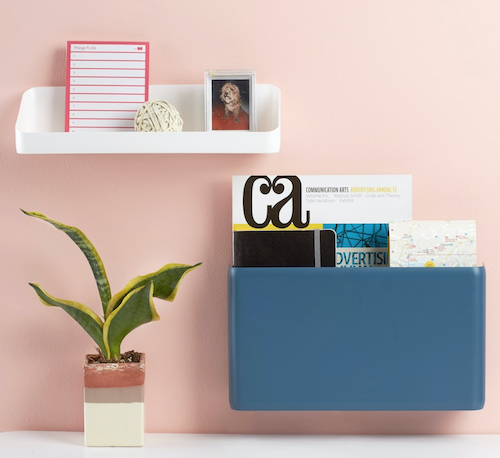
- wall cups ($14.50), measuring 4.5″W x 4.5″H x 2″D, in white, blush, dark grey, and slate blue
Each of the above products in the line are made of sturdy plastic polystyrene with a matte finish and come with removable adhesive strips, magnets, and screws for mounting. The removable adhesive strips hold up to 2 pounds; the magnets hold up to 1 pounds, and screws hold up to 15 pounds.
Poppin also makes dark grey fabric pinboards in two sizes, a 12.5″L x 12.5″W x 0.5″D square ($29) and a 25″W x 12″H jumbo version ($55).
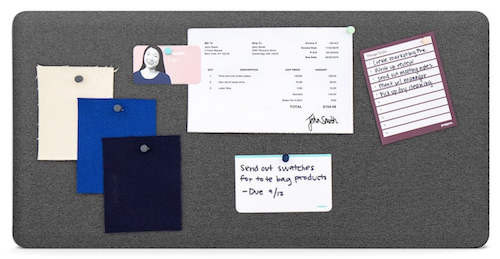
And, of course, they have a variety of pretty pushpins in assorted colors. But what I like best about Poppin’s “small space” line for making good use of vertical space is a product (actually three) they barely promote. There’s the white magnetic dry erase board ($26), measuring 12.5″W x 12.5″H x 0.5″D. But let’s face it, a plain white dry-erase board, even a magnetic one, isn’t that much to write home about.
But two other versions, with the same measurements and at the same price, up the ante. There’s the lined White Magnetic To-Do Dry-Erase Board:
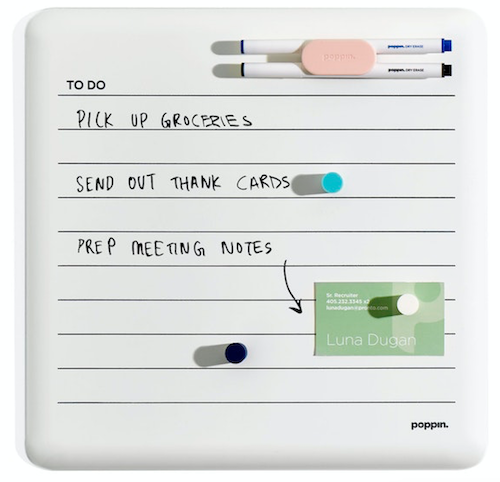
and the lined White Magnetic Weekly Dry Erase Board, pre-printed with the days of the week.

Of course, Poppin has pretty magnetic holders for the dry-erase pens and matching-color magnets.
Can’t you see these doing triple-duty at home, work, or in a dorm room?
TIKTOK MADE ME BUY IT
OK, TikTok didn’t actually make buy anything, but that’s what the voiceovers on so many of the little “advertainment” videos say. But TikTok did help me find two intriguing products.
PrintRGo
The first nifty office/school supply I saw recently kept appearing in my TikTok feed. It’s a tiny printer, and while I’m not the kind to push gadgets, I immediately saw the appeal of the PrintRGo thermal pocket printer. (Make sure you use the menu in the top right corner to switch from UK to US pricing.)

The use case may seem narrow, but if you’ve ever taken a biology course and had to label parts of a cell — and remember that the mitochondria is the powerhouse of the cell — or an studied for anatomy class where you had to learn a complex series of muscles, you know that you learn by spaced repetition and visual support.
Free-hand drawing and labeling is a pain, as is making copies. This little 3.4″ × 3.5″ × 1.6″ printer uses no ink, so you never have to wait for the ink to dry; instead, it uses adhesive-backed thermal paper to print at a maximum resolution of 203 DPI. (It does double-duty, so it also works some fun magic as a low-resolution photo printer and a label printer.)
Unfortunately, TikTok videos don’t embed particularly well, but this link will give you an idea of how the PrintRGo works.
In each box, you get a PrintRGo printer, charging cable, one roll of thermal paper, and a user’s manual. PrintRGo works via Bluetooth using the Phomemo app, and functions Android and IOS devices. It’s wireless, so you just pair it with your phone (just as with other Bluetooth devices like a Fitbit or keyboard) and you’re ready to print!
Take a photo with your phone, use the app to print it from your PrintRGo, and it thermal prints to sticker paper (at a speed of 10mm per second), and once you have your little masterpiece, printouts can adhere to your notebook or study cards.
Full-price for the PrintRGo is $78, but it’s currently selling at the official website for $48.
If you’re not comfortable purchasing from a TikTok advertiser, Amazon has a number of similarly adorable options that seem to work on the same principle, using the same Phomemo app. One version is the Phomemo M02 Pocket Printer ($49.99).
Bookmate
The other TikTok school/office supply that caught my attention disappeared from my feed (as often happens) when I fat-fingered (fat-thumbed?) the corner of my phone. No matter, because my fabulous friend and colleague Hazel Thornton independently sent it to me in a private TikTok message with a note, “New product for a blog post?” Indeed, it is!
Bookmate from AchieversMust appears to be designed primarily for teachers and students, but really anyone who reads and tends to annotate, take notes, or mark pages for followup will find it useful for reducing clutter. Bookmate combines one magnetic case (which holds sticky tape flags for marking pages and pen loops so you always have a writing tool or highlighter handy) and a magnetic base.
The case allows for you to refill the sticky flags, and you can use any standard tape flags to refill the Max or Pro cases, or purchase the same specific colors from AchieversMust. (You can only refill the Lite version with their tape flags. FYI.)

You put the magnetic base inside the front of your book or notebook and the magnetic case (with your tape flags and pens) sticks to the front. (The company claims the magnet is strong enough to adhere through a hardcover book, but I’m a twinge dubious.)
Some photos show users hanging glasses or sunglasses from an outer loop. Again, TikTok videos are wackadoodle when it comes to embedding, but you can see Bookmate in action on the Instagram page.There are three versions of the Bookmate:
- Max — has four pen loops (two on each side) and a 200-count of flags in ten different colors, for $39.95
- Pro — has four pen loops (two on the left, two on the right) (two on each side) and a 100-count of flags in six different colors, for $33.95
- Lite — has two pen loops (one on each side) and an 80-count of 2 different tape flags, for $19.95
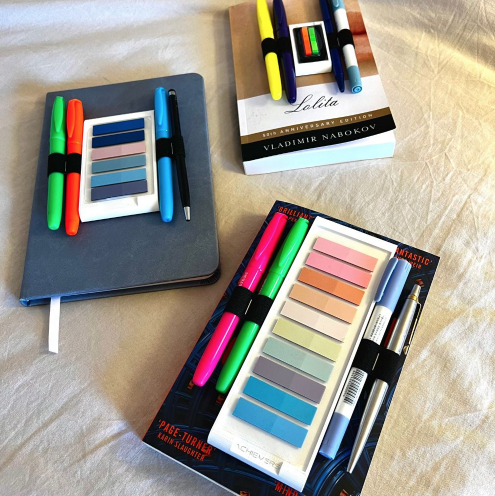
They offer free shipping on all orders above $60. Also, from now through September 10, 2023, you can buy two at 10% off each or buy 3 at 25% off each. (There’s also a 30-day money-back guarantee.)
EVERYTHING OLD IS NEW AGAIN
I remember visiting my father’s law office when I was a child, and I noticed that every attorney’s desk had a serious-looking leather desk pad. As a student in the 80s, my real work desk was wherever I found myself — a library study carrel, my bed, a random table in an empty classroom. By the time I started working in television, the closest anyone seemed to get to a desk pad was a giant desk calendar.
Nowadays, nobody is using a desk pad for blotting a fountain pen, but desk protectors are back in style. I was roaming through a big box store this weekend, looking for a lightning cable to use in my rental car (as mine is still in my stolen, damaged, recovered, and still-not-repaired Kia), when I noticed a stack of what looked like miniature yoga mats.
It turns out they were oversized desktop mouse pads. The one that caught my eye was a 35″ x 16″ pink, flowered, onn.-brand (yes, it’s “onn.”) XL Desktop Mouse Mat with an anti-slip base. The style is called Surf. (It also comes in grey and rainbow-stripes.)
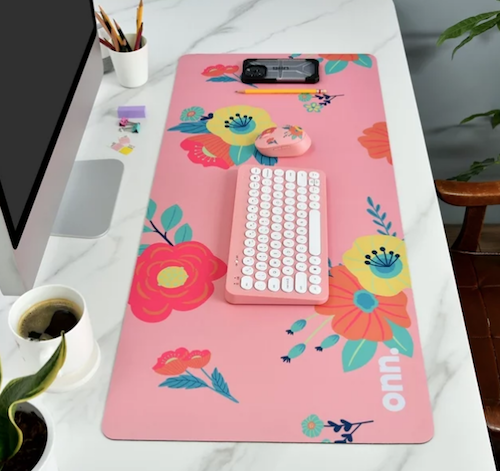
And it was only $9.88!
It’s been a long time since I looked for a mouse pad or a desk mat, so I was surprised and delighted by how many products, marketed as either oversized mouse pads or desk pads, were available to brighten up the work space.
Yes, the real purpose is to give you a larger space to roll your mouse while keeping your glass or wooden desktop free of scratches, spills, dust, stains, and all matter of the detritus that ends up crumbly and sticky and yuckified on your desk. But why not feel like you’re basking luxury while doing homework or eking out a living?
Paper Doll is Clearly Organized — Translucent Tools for Getting it Together
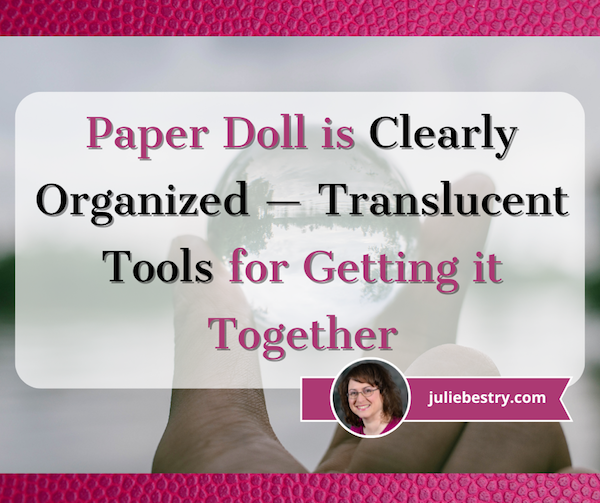
THE LOOKS OF THINGS
Quite often, when people talk about tools for getting organized and productive, they talk about the way products look. However, if you’ve been a longtime reader of Paper Doll, you know that I’m a firm believer in focusing on function rather than aesthetics. No matter how pretty or spiffy or intriguing a product looks, if it doesn’t work well, and help you work well, then it’s a bit pointless.
That doesn’t mean I don’t recognize the psychological value of how things appear. For example, I’ve talked about how color can play a motivational role:
Cool and Colorful Desktop Solutions to Organize Your Workspace
Paper Doll Adds a Pop of Color with Bright & Sunny Office Supplies
Ask Paper Doll: Should I Organize My Space and Time with Color?
Organize Your Days With a Little Color
For me, I can’t resist things in the pink and purple range. I’ve written before about how I am a steadfast adherent to my Roaring Spring purple legal pads, and I have a purple iPhone and iMac.
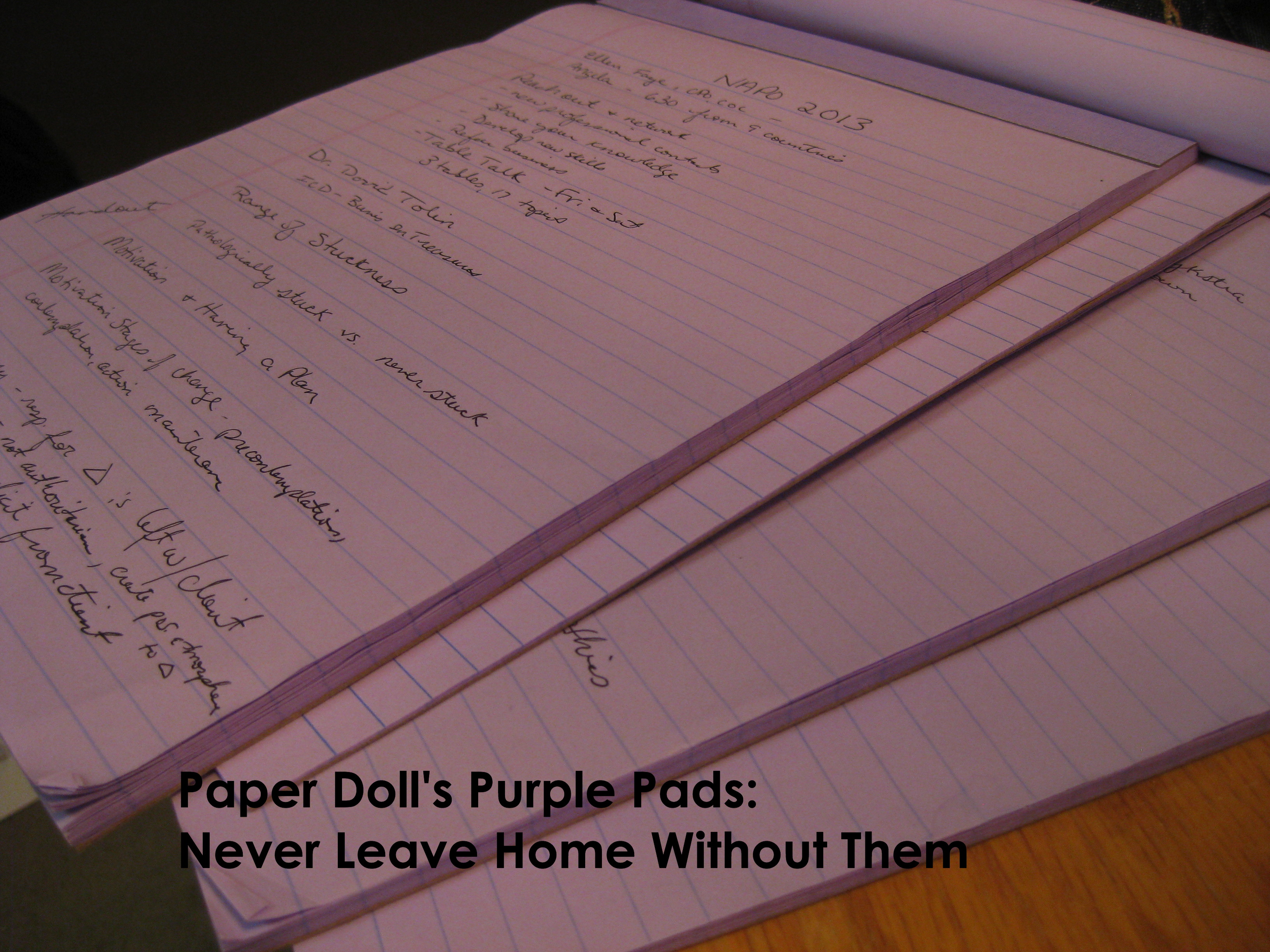
Almost anything I can purchase (for the same price as the bland and boring version), I’m likely to acquire in pink or purple. As much as I try to avoid duplication, even though I have a lovely pink Swingline stapler that is perfectly serviceable,

when a generous colleague gifted me a pink Mustard-brand Bunny stapler, I couldn’t resist keeping it in my office space, too. (And yes, I do make “boing-boing-boing” sounds effects when I use the bunny stapler. Need you ask?)
Paper Doll Organizes Temporary Papers and Explores Third Spaces
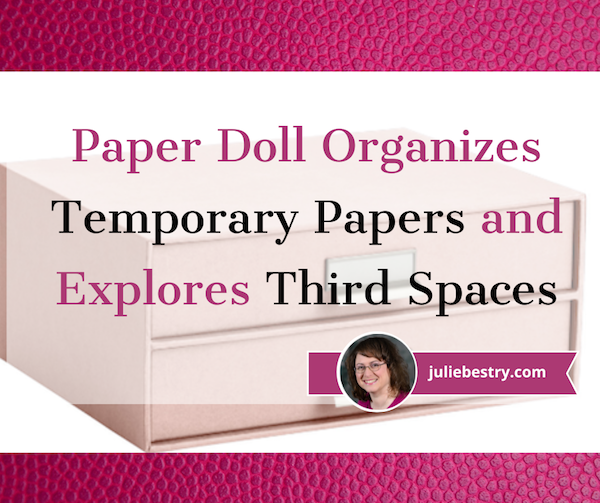
WISDOM IN THE COMMENTS SECTION
Although the comments sections of most locations online can be scary, organizing and productivity blogs tend to avoid that unpleasantness. In fact, some of the niftiest ideas for posts come from the comments sections of other posts.
Last week, commenting on the cute magazine files in Paper Doll Refreshes Your Paper Organizing Solutions, Sara Skillen mentioned:
I’ve always loved magazine holders for all kinds of paper…but also, high quality, shallow, flat trays work for a lot of my clients (those who pile). I know, I know, we all think piling is not a great idea, but for temporary kinds of paper like bills, notices, etc. it can be an amazing solution. Less barrier to putting things into broad categories, and easy to dump in the recycle bin when things are no longer relevant. I’m also a fan of very small filing boxes (like the Bigso ones at the Container Store) for temporary paper. Easy to place on the desk for quick access.
I think that Sara and I might slightly disagree about what constitutes “temporary” paper. I believe that if you receive a paper bill, the best practice is to have a system in place so that you not only pay the bill, but file and store it for later (potential) retrieval for tax purposes, troubleshooting, budgeting, etc.
However, Sara has truck on a topic that we discuss far too infrequently — paper that doesn’t fit into either of the two main, overarching paper categories.
Last week, I referenced a guest post I’d written for Yve Irish’s blog. In that guest post, How To Make Paper Less Overwhelming, after discussing the reasons why paper management can be so difficult, I wrote:
Paper categories can be much more complex and require more thought than most other tangible items. It starts off easily enough, with two basic categories:
-
-
-
Action paperwork — This reflects all the paper that triggers an activity. From the lowly coupon for a free car wash at the new Wash-o-Rama to the reminder postcard for your medical appointment to the registration forms for your child’s summer camp, action paperwork is relatively easy to corral in an in-box or my preferred method, a tickler file. (Getting motivated to actually do the tasks is another issue altogether.)
-
Reference paperwork — If a piece of paper doesn’t trigger an action, but it’s something you need (or want) to keep for later retrieval, it’s reference.
-
-
In between the action paperwork that’s designed to trigger us to do something and the reference paperwork (whether current, or archival) for us to keep records at least semi-permanently (until they expire or are replaced), there’s a third category of papers that neither requires our activity or our long-term storage. For want of a better name, let’s go with Sara’s simple title, temporary papers.
WHAT ARE TEMPORARY PAPERS?
Beyond describing what they are not, let’s look at what constitutes an example of a temporary paper.
- Receipts — Certainly, there are different categories of receipts, each treated differently. If you’ve purchased something in cash that is not, for whatever reason, going to be returned, you can immediately shred or toss the receipt. A lunch at fast food restaurant comes to mind.
Other receipts need to be filed and kept semi-permanently, such as for any big ticket items for which you’ll need to prove value or ownership (like a piece of jewelry) for insurance purposes or use as support for your taxes.
But there are a whole slew of receipt types that you may need to keep temporarily, for short-term purposes. For example, if you’re cautious about making sure your credit and debit card receipts are accurate, you may keep a month of receipts (please — tidily in an envelope for that month and not crumpled all over your dresser) until the credit card bill comes or you remember to check online. (Restaurant receipts seem to be the most common culprit for inexact matches. Although sometimes the charge reflects a tip much higher than what you wrote on the slip, I recall one restaurant that regularly (at least 25% of the time) failed to apply the tip. Eventually, I gave up and started tipping in cash.)
Another common temporarily-maintained receipt is for any purchase you might return. Except around the December holidays, most retail locations have a return policy limiting returns to no more than 30 days. It’s understandable that you wouldn’t want to file away a receipt only to dig it out a few weeks after you make a purchase; you’ll want to have those receipts handy in case something fails to fit or flatter. (Some people, like Paper Mommy, hold onto their grocery receipts in case something turns out to be yucky or spoiled; only you know whether you have the time and willingness to return a $3 bottle of salad dressing.)
- Temporary Driver’s License — To get a driver’s license, you generally have to go to the DMV, fill out all the forms, pay a fee, and take a written test and a driving test. If your experience doesn’t turn out like Reverend Jim’s on Taxi, you’ll be approved for a license and then have your photo taken.
(If the last minute or two of this video doesn’t make you feel like the laughing-crying emoji, I don’t know how you ended up on my blog.)
However, because driver’s licenses are hard, fancy plastic cards with bar codes and holographic images and sometimes magnetic stripes, you generally don’t get your real driver’s license the same day. Instead, you usually get a paper printout of what your card should look like.
When you come from another state, most DMVs will require you to turn in your out-of-state license, and your temporary license is all you have to prove that you are a licensed driver until the real license arrives. You’ll want to keep this temporary license with you, in your wallet until the new, real license is in hand.
However, if this is a driver’s license renewal, the paper version is just your proof that your new license, with an extended expiration date is coming. If you’ve renewed at least a few weeks ahead of the expiration of your current license, there’s no need to carry the temporary paper around with you (unless you’re afraid you’ll forget that the process isn’t complete. In that case, set a reminder on your phone for a day before the expiration date to make sure you’ve received the new license and replaced the old one in your wallet!).
- Shipping and Return Slips with Tracking Information
When you ship packages and documents, the United States Postal Service has a variety of ways to ensure that you can protect your package and track its progress. For example:
Registered Mail Receipts and Tracking Numbers — Registered Mail provides security when you send something that’s difficult to replace, valuable, or otherwise needs to be tracked for additional security. You might choose Registered Mail if you’re sending something via First-Class Mail, First-Class Package Service, or Priority Mail. In theory, at least, your mail or package is secured in a sealed container or locked cage or safe during transportation, and the USPS obtains electronic and physical signatures to show you the chain of custody along the way.
You get a receipt for the item when you send it, and the then your recipient must sign for it. And if you want proof that the item was delivered, you can purchase Return Receipt or Return Receipt After Mailing service and get electronic verification of either delivery or an attempted-but-failed delivery.

Mailbox Photo by Abstrakt Xxcellence Studios
When you send a letter through Registered Mail, the post office gives you tracking information. This is important to keep handy so that you can type the tracking number into the online system or scan the QR code or bar code to track the item until it arrives at its destination. At that point, whether you keep it or not depends on the situation.
You get similar information when you send something through a delivery service like UPS or FedEx. Have you ever returned an Amazon package at a UPS store or another retail location? Brandish a printout of an email or show a QR code on your phone, and a staffer enter the essential information into the computer and hand you a sticker with the vital details, including the tracking code. Type the string of letters and numbers into the delivery service’s tracking system (or even directly into Google!) to track your item.
So, if you’re making sure your grandchildren got their birthday gifts and your son-in-law calls to let you know the LEGO arrived, the temporary paper (the tracking slip) can be discarded. (Let’s hope you don’t have to wait for toddlers to get old enough to write their own thank you notes!)
If, however, you’re returning an ill-fitting or broken item to Amazon or other vendor, you’ll want to hold onto that temporary paper until your account has been properly credited or a replacement item makes its way to you.
USPS Certified Letter Receipt — Certified Mail is similar to, but not the same as Registered Mail. With Registered Mail, you get all that yummy tracking goodness, but you’re (allegedly) getting extra security for your item. However, with Certified Mail, you’re just paying for tracking and proof of delivery, generally for important documents like tax returns, legal notices, and financial transactions.
To send a certified letter, you fill out two forms, a flimsy piece of green and white paper and a stiff green piece of card stock.

The flimsier piece of paper is your receipt, and it shows your unique article number so you can prove the piece was mailed and track the delivery status online. When it gets delivered, you’ll get notified of the time and date of delivery and then you’ll get the signed green card back in the mail.
If you’ve taken the measure to send something via Certified Mail, it’s pretty likely that you’re going to want to prove, longer-term, that the thing you sent was delivered, so your receipt (and the eventual green card) may not be so temporary.
It may be temporary while you’re waiting to confirm delivery, but if you don’t get proof of receipt, it’s likely to turn into an action item, because you’ll have to fuss with the post office, but even if it is delivered, you’ll then have to wait for the attorney, the IRS, or the person you’re paying to acknowledge that the item was received and that they are actually acting upon said receipt.
So, your Certified Mail paper may go from being temporarily temporary paper to being action paper (and go into your tickler file) and/or permanently stored in your reference paperwork in case there are long-term legal or financial implications.
- Problem/Conflict-related Papers — How often do you receive a bill that appears to have a mistake on it? Do you ever get a notice about a recall for your car or a household appliance? Ever get invitations to showers or weddings that give no indication of where the person’s gift list is registered?
Sometimes, you open the mail and immediately make a call or send an email asking for clarification. And then you wait. And wait. It would be nice if all questions and conflicts could be handled within moments, but sometimes you have to wait hours or days for a response before you can determine whether the temporary piece of paper is now fodder for the trash or recycling bins or needs to be scheduled as task or filed away.
So what do we do with this temporary paper while we wait?
WHERE SHOULD YOU KEEP TEMPORARY PAPERS?
There are two main approaches to keeping temporary papers. As much as I’m tempted to say, “my way or the high way,” it really is a matter of either Paper Doll‘s way or a Third Space way.
Tickler File
Longtime Paper Doll readers know I like using a tickler for action-oriented paperwork. It avoids paper clutter on the desk, and it triggers the owner of the paper to make decisions about when and how the piece of paper will be acted upon. How strongly do I feel on the topic? Well, I did write a whole ebook about it!

Whether you purchase a tickler file with slots for each day of the month and for each month of the year or create your own DIY version with 43 file folders, you get a parking space for anything that requires, or might require, action. Sometimes, the action required is checking to see whether you still need to be waiting.
Paper Doll Refreshes Your Paper Organizing Solutions
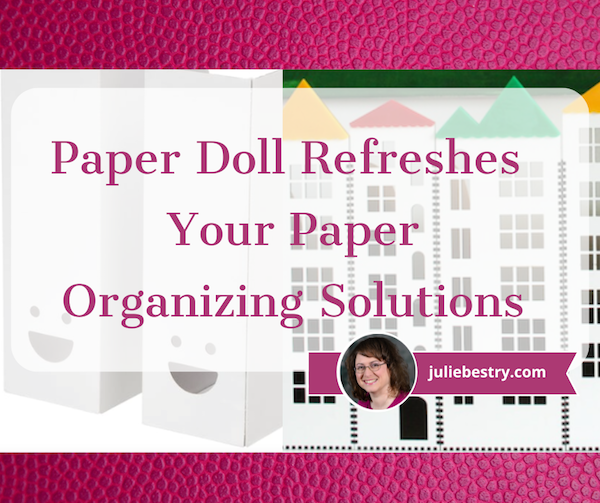
Springtime gives us an opportunity to refresh how we do what we do. Today, we’re going to give some new thought to our obstacles and strategies for keeping our papers organized, and then take a peek at opposite ends of the spectrum for paper storage solutions: one fun and one seriously sturdy.
REFRESHING YOUR PAPER PROCESSES
My friend and professional organizing colleague Yve Irish in Rochester, New York recently asked me if I’d like to write a guest post for her blog.
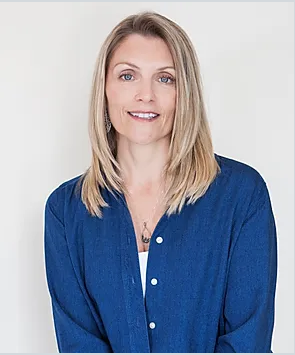
We’re in the same Mastermind group, and we’re often talking about how we can help support one another’s businesses, and this seemed like a fun opportunity. It made sense for me to talk about my favorite topic — paper!
How To Make Paper Less Overwhelming
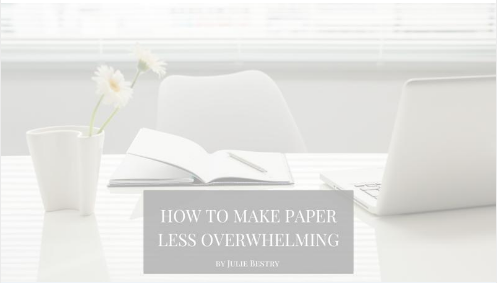
In that post (which is much shorter than the typical Paper Doll post, so you might not need a sandwich to sustain you as you read it), I cover:
- Why it’s so difficult and frustrating to keep paper organized
- The difference between action papers and reference papers
- How to break your files down into clear categories so that you can quickly file them and easily access them again when you need a specific document
- Secrets for success when trying to get — and keep — your papers in order.
I invite you to read the post and visit the rest of Yve’s blog at your convenience. Tell Yve I said “Hi!”
MAKE YOUR SPACE HAPPY WITH MAGAZINE FILES
Most of the time, when we talk about keeping paper organized, we focus on using files folders. (In the guest post above, I even explain why file folders are usually preferable to three-ring binders.) But there are definitely other paper storage solutions, depending on the types of paper we’re talking about.
For example, if the paper is teeny-tiny, like an index card, there are a variety of appropriate storage options, such as I discussed in The Humble Index Card: Organize Your Life, Then Organize Your Cards.

Similarly, although we don’t discuss them often, there are a variety of uses for magazine files. For example, you can use them to store:
- Magazines — Duh! But don’t keep all of your magazines forever, or the foundation of your house will buckle. Instead, magazine files are great for maintaining the most recent month of your subscriptions. When the new ones arrive, you can sub them in for last month’s issue. Magazine files are also useful for keeping oft-referenced magazine issues on a particular topic, such as holiday issues for recipes (though I’d still suggest creating your own recipe file system, as I suggested in Calm Cooking Chaos (Part 1): Organize Your Paper Recipes).
- Store Catalogs — If you like ordering from catalogs, or just have fun flipping through them and dreaming about what you might buy, neatly stashing catalogs in a magazine file keeps them tidy and accessible. Do note, however, that almost all catalogs have the same items in them month and after month, just with different layouts and updated pricing, so there’s no need to keep old catalogs once the new ones arrive.
- Travel Brochures, Maps, and City Guides — Although I’m not ready to get back on airplanes (which felt like germy tin cans even before COVID), I had so much fun on my Smithsonian tours of Italy (2018) and the UK (2019) that I keep the most recent Smithsonian Journeys catalog of trip options so that I can refresh my inner aspirational traveler. You might like to keep a magazine file of local city guides on a side table in your guest room to help overnight visitors consider where they might like to dine or travel.
- Instruction Manuals — For simple manuals, a file folder works fine, but depending on how many manuals you keep, and the sizes of them, or if you’re short on filing space, you might want to maintain a bookshelf of matching magazine files. Consider separate magazines files for different categories, such as:
- Major household appliances (water heater, refrigerator, washer/dryer, electric garage door)
- Kitchen appliances (air fryer, food processor, bread maker, microwave)
- Home theater electronics (televisions, stereos, DVRs)
- Computer hardware and software (including peripherals like printers and scanners)
- Communication devices (phones, digital assistants like Home Pod or Alexa)
- Personal electronics (smart watches, ebook readers, pedometers, heart rate monitors)
- Specialty manuals (exercise equipment, home medical equipment)
- College Catalogs — Once your kids start taking the PSATs and other pre-college tests, they will receive a shocking number of catalogs for colleges and universities in far-flung places. (A few years ago, I went back to my childhood home and found that my teenage closet was still filled with multiple paper grocery sacks of college catalogs circa 1984-1985, and I would not be hyperbolic in stating that at least 20% were, mystifyingly, from Valparaiso University in Indiana.) Try to keep only the catalogs for schools to which they’re likely to apply (and not your dream schools).
- Phone/Address Directories — We rarely see old-style phonebooks, the ones suitable as booster seats for toddlers. Many communities no longer have “white pages,” at all, and where “yellow pages” exist, they’re often about the thickness of a magazine. Church and school directories are often only available online. But if you do have bound directories, keeping them all together in a magazine file makes it handy when you need to make a call.
- Takeout/Delivery Menus — You probably use your phone to order delivery or get takeout. But new restaurants will still stick their menus under your windshield or between your screen door and front door, so whether you want them or not, you’ve probably got a pile of them. Don’t just stack them on the microwave or stick them in a kitchen drawer — but do keep them if the food appeals to you. When Paper Mommy, my sister, and I are together in my sister’s city, we often have to juggle phones to plan food delivery. My sister has an Android, so she can’t Airdrop a menu to the two of us (Apple users); instead, she tells me the name/URL of the restaurant, and I look it up and then Airdrop it from my phone to my mother’s iPad. It’s a whole process even before we start figuring out what we want to order. Having a takeout menu collection might make it much easier. Just plop the ones from which you’re likely to order in a magazine file.
I recently found a few intriguing magazine files.
First, Ikea’s TJABBA (a variation on their only-slightly pricier but less adorable TJENA magazine file) is currently on sale for only 99 cents/2 pack, so I suspect it won’t be around long, but it’s so cute!
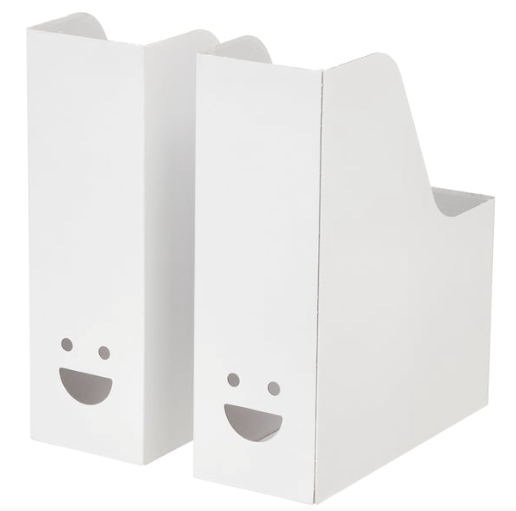
The smiley face design is made by adding two tiny punch-out circles above the open space used to pull the file off of the shelf. You get a sneak peek of the contents but still get to keep the “messy” side of the magazine file toward the wall.
The TJABBA files are easy to assemble and can collapse and fold up to save space if you don’t need them for a while. They measure 9 3/4″ deep, 11 3/4″ high, and 4″ wide.
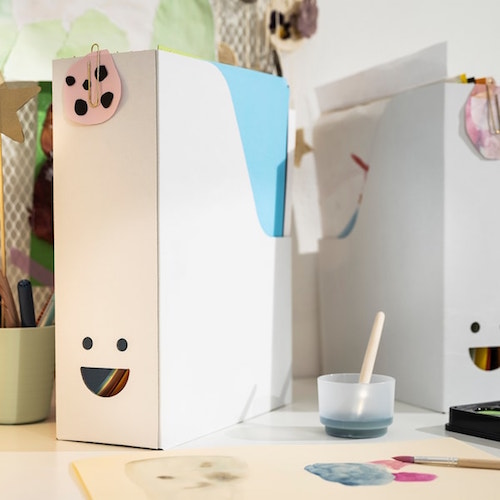
If you prefer to support independent small businesses and don’t mind waiting a little extra time for shipping, the Bluble shop on Etsy has magazine files designed to look like townhouses. They’re handmade of “woodlike” (or solid color) laminated high density fibreboard.
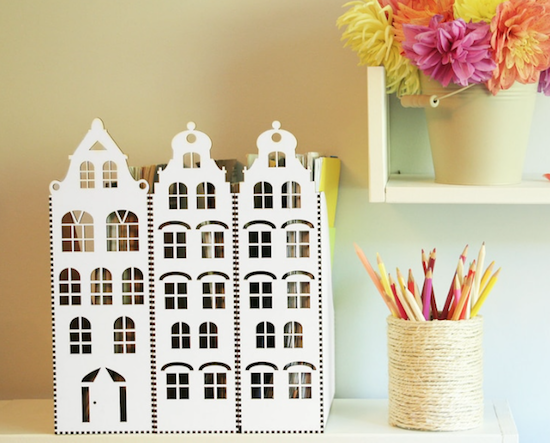
There are three styles of these magazine files:
# 1 measures 34.7 cm high, 11.0 cm wide, and 23 cm deep
# 2 measures 34.3 cm high, 9.3 cm wide, and 23 cm deep
# 3 measures 34.5 cm high, 8.0 cm wide, and 23 cm deep
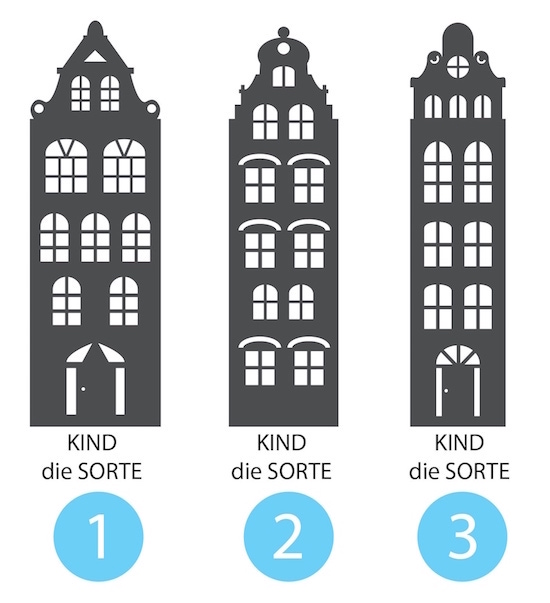
You can select any of the three styles in a variety of colors, depending on what kind of cityscape you’d like to create on your shelf. The options are maple, oak, pine, cherry, apple, nut, “wenge” (sort of darker brown), black, grey, and white.
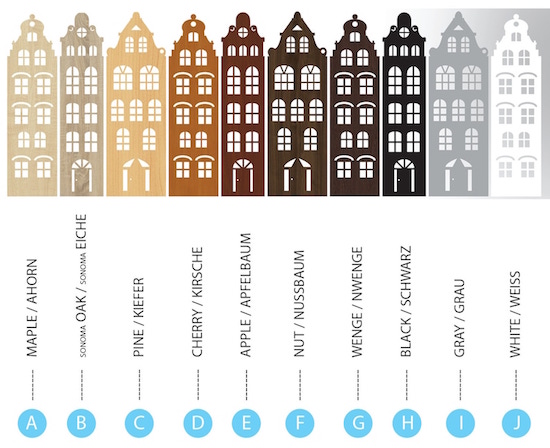
These Bluble storage solutions are $5.70/each, which seems incredibly reasonable for a hand-made townhouse-style magazine file, but Etsy calculated that shipping from Germany to my own zip code would be $28, so this might be better if you are planning on buying many of them for practical décor and not just to hide in a cabinet.
If you order, be prepared to state the number for the type you prefer along with the letter for the finish you want. (I’m fond of the wider townhouse #1 in pine or white, but you could mix-and-match to create your own cityscape).
Bluble also makes a version of these townhouse magazine files with different window and door stylings and colored rooftops. The color options are navy blue, blue, light blue, mint, green, light green, black, violet, red, orange, and yellow. These magazine files run $6.23/each.
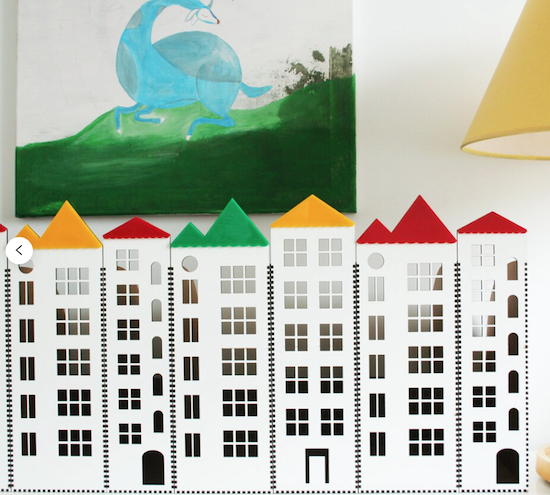
SOLVE STORAGE FOR A TON OF PAPER
It can be really annoying when you have a lot of paper that you need to store, but there are a variety of solutions depending on whether you have a little bit of a lot of paper or a whole lot of a lot paper.
Traditional (manilla) file folders are scored on the bottom (near the crease), so with a little bit of effort, the bottom of the folder can go from a sharp fold to a boxy-bottom, but that can only help add contents for so long. Plus, if you increase the bottom surface area of your file folder by folding it at the creases, fewer folders will fit in a traditional hanging folder, and eventually, that’s going to present a challenge.
Box-bottom hanging folders and expandable files are the traditional solution, and you can generally find them in sizes that providing expanding room for one-to-four inches of paper storage space, but they’re not particularly attractive.
Recently, I came across a product from our friends at Smead, a 3.5″ Hanging File Pocket with an interesting design.
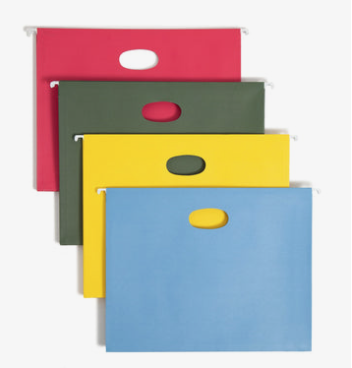
Smead 3.5″ Letter-Sized Hanging File Pockets
Suitable for collections of lots of bulky documents that you need to both hang and transport, the 3.5″ Hanging File Pocket is strong enough to expand to 3 1/2″ and has oval die-cut handles to make it easier to lift and transport a large collection of papers.
These 3.5″ Hanging File Pockets have full-height gussets (reinforced accordion-like sides rather than the typical open-sides you find with hanging folders). The gussets ensure that the paper contents of the pockets will stay secure and won’t get stuck on the file rails when the pocket is removed from a file drawer.
While the accordion style sides will expand to up to 3 1/2 inches, they take up minimal space until/unless the expansion for extra capacity is needed. For example, if you’re putting in documents for one fiscal quarter, no expansion is necessary, but as you add more paper for additional fiscal quarters, more expansion can occur.
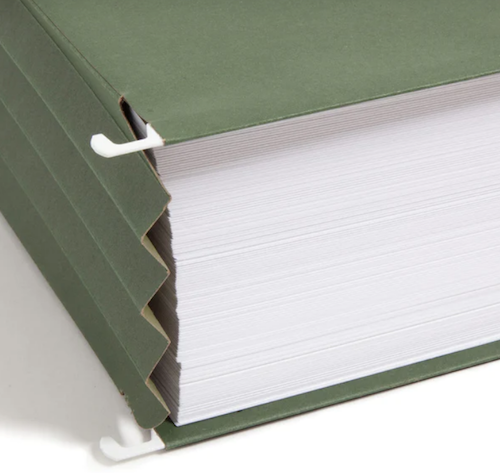
The Hanging File Pockets come in two sizes:
- Letter-sized are 11-3/4″ wide by 9-1/4″ high, not counting the hanging rods, which add an additional inch (total) of width
- Legal-sized are 14-3/4″ wide by 9-1/4″ high, not counting the hanging rods, which add an additional inch (total) of width
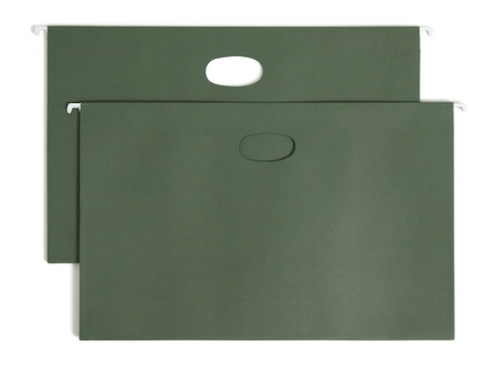
Smead 3.5″ Legal-Sized Hanging File Pockets
The letter-sized file pockets come in standard green or multi-color (red, green, yellow, and blue); the legal-sized version are only available in standard green.
(Boo! I wish someone at Smead or any of the other file supply companies could tell us whether green hanging folders and jackets are somehow less expensive to produce. Like, is Army Green a less expensive coloring agent? Why are filing solutions in pretty colors almost always more expensive?)
I should note, these Hanging File Pockets are priced for corporate use for lawyers, accountants, and people who wear serious suits each day. The pockets, and specifically the die-cut ovals that make these heavy-duty hanging file pockets so appealing, aren’t really designed for residential or home office use, the assumption being that the average person or small business isn’t going to need to keep an entire ream of paper in one folder or pocket.
The pricing is:
- $38.50 for four of the letter sized, multi-color (red, green, yellow, and blue) 3.5″ hanging file pockets (Yes. Almost $40 for four hanging pockets!)
- $75.33 for ten of the letter-sized, standard green 3.5″ hanging file pockets
- $83.61 for ten of the legal-sized, standard green 3.5″ hanging file pockets
- There is no option for the multi-color hanging file pockets in a legal size
These 3.5″ Hanging Pocket are only available directly from Smead.
Happy Spring from Paper Doll HQ, and please let me know if you spot any fanciful or fun paper storage solutions in the wild and I’ll be happy to credit you in a future post.
Cool and Colorful Desktop Solutions to Organize Your Workspace
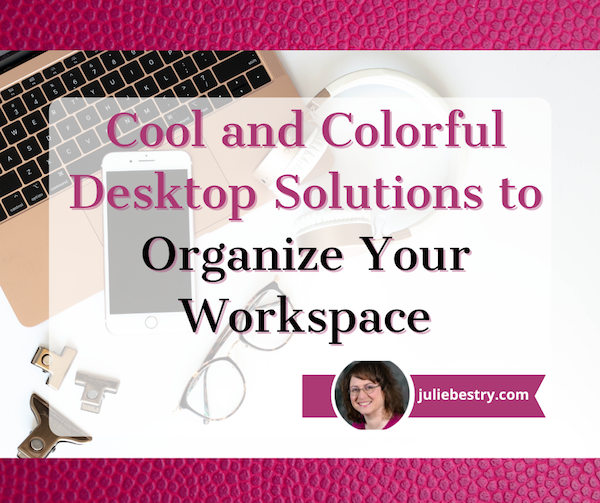
June is odd. In much of the county, school has let out (or soon will) and both kids and teachers have been set free. New graduates are gearing up to start their first jobs, while some workplaces have started to shift to summer hours or half-day Fridays. It’s already in the 90°s for many of us, and mojo is in short supply, but the bulk of us aren’t getting summer vacation.
I have a short series coming up soon about lack of motivation, burnout, toxic productivity, productivity dysmorphia, and ways to beat the psychological obstacles to getting organized and staying inspired. But today, we’re going to look at something a little more lighthearted. Sometimes, a little retail therapy (even just via window shopping) can improve our moods and make us a bit more motivated to tackle our stuff, tasks, and spaces.
So, here are a few of the products I’ve seen lately that made me pause and go, “Hmmm.” Be sure to jump into the comments and let me know what you think!
MOFT INVISIBLE LAPTOP STAND
Sometimes, minimalist products can maximize results.
Whether you’re working at your desk at HQ, from your home office or kitchen table, on an airplane, at a picnic table in the sunshine, or in the corner coffee shop, the ergonomics of your workspace setup is important. When you have a permanent desk, it’s easy to arrange for a monitor riser so that your screen is at the right height, but portable risers can be heavy and inconvenient, and working while mobile can bring unexpected miseries. Wouldn’t it be nice to have something lightweight and easy to maneuver?
Enter Moft, maker of device accessories. They state, “Most productivity accessories are rigid, bulky and heavy-eeping you tied to a specific location. We wanted to create something flexible, functional, and non-intrusive that goes everywhere we go, allowing us to be productive anywhere life’s adventures take us.”
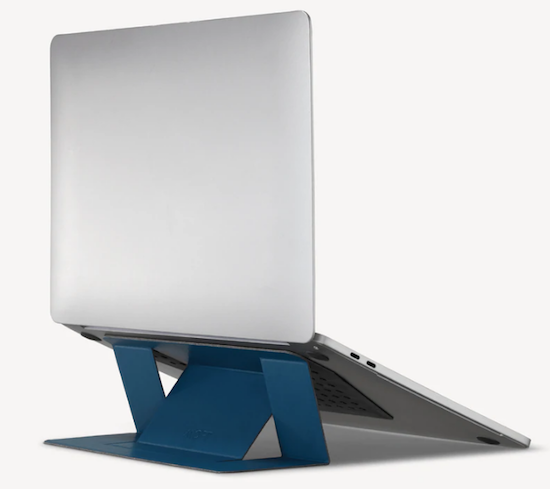
MOFT’s Invisible Laptop Stand is hard to describe but quick to impress. When flat and not in use, it’s ridiculously thin at only 0.1″ thick. It’s constructed out of “vegan” leather (didn’t we used to call that vinyl?) and heavy-duty fiberglass.
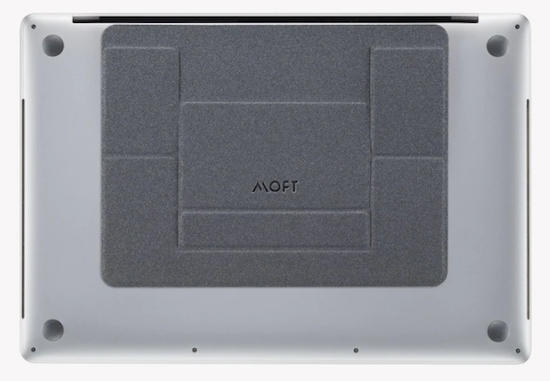
When flat, you’d barely notice it, but once attached to the bottom of your laptop (with residue-free adhesive) and adjusted to either of the two possible angles, the 3-ounce stand supports up to 18 pounds of laptop weight.
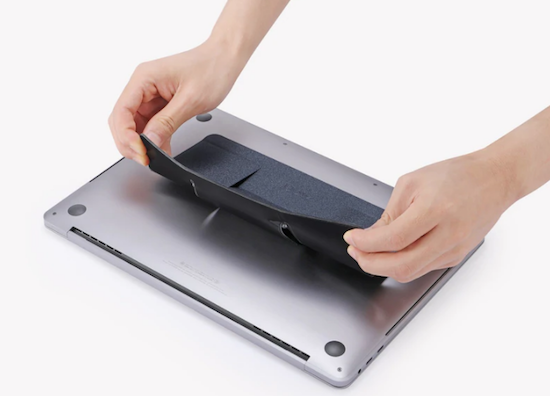
With built-in magnets, you can easily raise your laptop to the right height in a snap. There are two elevation angles to maximize your comfort. Use the “high-lifting” mode when you are sitting, and raise your laptop 3 inches (at a 25° angle); if you’re using a standing desk or working at a counter, consider the “low-lifting” mode of 2 inches to raise your laptop to a 15° angle.
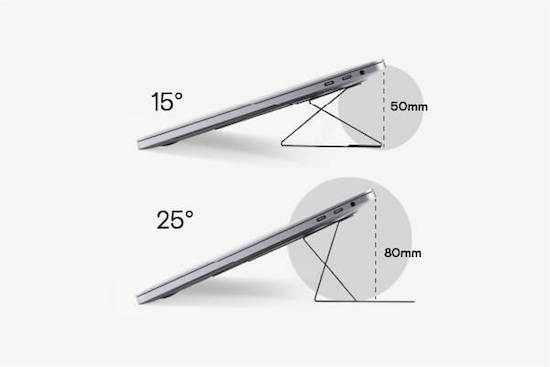
Since it’s lightweight, portable, and (usually) attached to your laptop, there’s no need to create other space in your bag to accommodate it and you won’t have to worry you’ll forget or misplace it.
The Invisible Laptop Stand comes in Silver, Space Grey, Jean Grey (like the character from X-Men), Wanderlust Blue, Sunset Orange, Cool Grey, and Jet Black. (And yes, if you click through the photos at the site, you can see that all those greys really are different.) There are also limited-edition versions, sold two-for-the-price-of-one, in Pink (shown below) and Gold, sold only in the US.
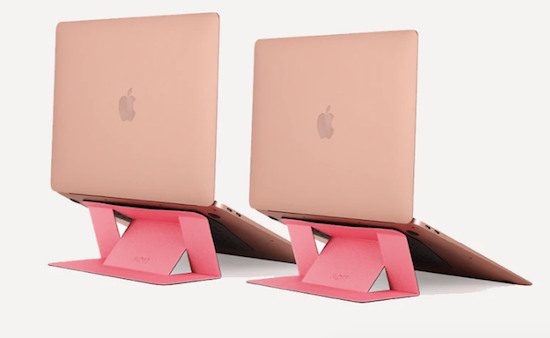
The adhesive is residue-free and can be removed and reapplied (or attached to different computers) up to half a dozen times.
The MOFT Invisible Laptop Stand can be used with laptops measuring between 11.6″ and 15.6″. However, they don’t recommend using it with laptops that have vents on the bottom surface, as the stand would block airflow. For users with laptops with bottom vents, they recommend their non-adhesive version (available only in Silver and Space Grey). Because it doesn’t stick to the back (bottom) of your computer, setup in a twinge slower, but still easy, and works with computers measuring 11.6″ to 16″ (with the exception of 14″ MacBooks, which have little rubber feet).
The adhesive versions of the MOFT Invisible Laptop Stand are $24.99; the non-adhesive versions are $29.99. They are sold directly at the MOFT site; Amazon sells them at the same price, but has a very limited availability of colors.
For those using a multiple-device workspace, note that MOFT also makes stands for tablets and phones.
SPECTRUM WALL HANGER
Are you at the point in your year where you really wish you’d invested in a full-sized wall calendar for planning big-picture projects, but you can’t justify the expense of wasting half a year of calendar pages? Or, if you know there are undated wall calendars, you may be uninspired by them.
Poketo’s Spectrum Wall Planner may be just what you need to brighten your office and your mood.
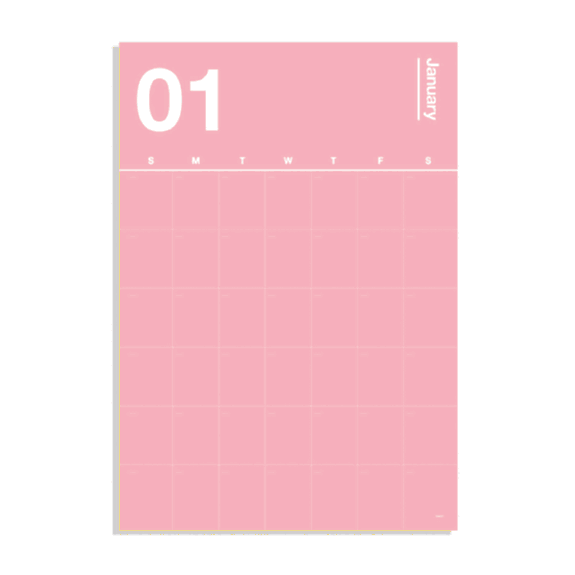
Each of the twelve pages in this poster-sized wall planner looks like it has made friends with the color schemes at Pantone. (Need a refresher? Read Ask Paper Doll: Should I Organize My Space and Time With Color?) The pages are undated, so you can start planning with your summer months and continue on through to next spring.
While I’d be inclined to post two months simultaneously (this month and next month), Poketo encourages users to decorate your walls with anywhere from 4-12 planner pages to make this a more powerful long-term planning tool. You can use any poster hangers or adhesives you have available, though they do sell an Acrylic Poster Hanger for $32. (At that price, obviously, hanging only one or two pages concurrently would make more sense that a 12-month set.)
The 12 monthly pages each measure 30.0″ x 20.6″ and are made of FSC-Certified tree-free paper to be gentler to the environment. (Unfortunately, the site does not reference whether the paper is made from stone or other materials.)
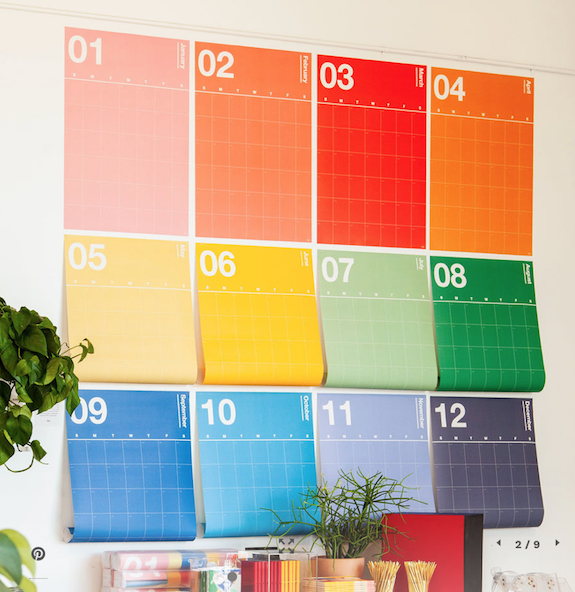
The Spectrum Wall Hanger is $48. (To be clear, this is not a reusable or dry-erase product; it’s one-and-done, so only invest if you’re craving bright colors to brighten your space.)
Poketo also carries a line of tree-free Geometric Sticky Notes in “Warm” and “Cool” tones for $8 per set to help theme or code your wall planner. The 5″ x 5″ notes sets come with 15 notes per shape and 60 notes per pad.
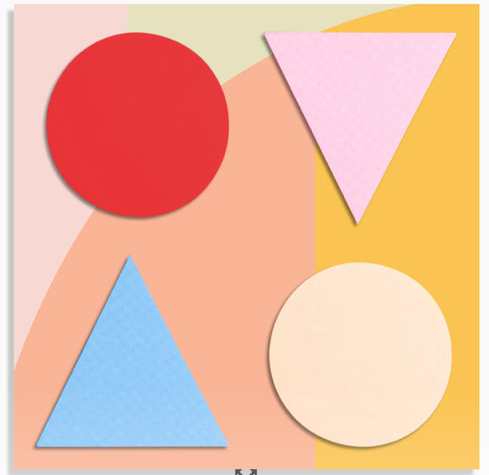
CABLE WRANGLER
Longtime readers of the Paper Doll blog know that I love magnetic things. Way back in 2014, I sang the praises of the MOS system in Paper Doll’s Cable Conundrums & the MOS: Magnetic Organization System.
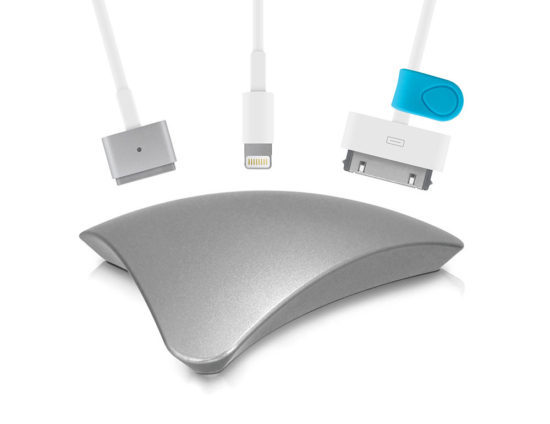
I still use two, a silver aluminum version at my desk to match my Mac products (now silver and purple) and a white plastic version at my bedside, to ensure that when I unplug a lightning (or other) cable from a device, I don’t have to go searching for where it’s squiggled itself away. I loved that it worked horizontally or vertically, and that the price was reasonable.
Sadly, the MOS is no more. Sewell, the company that originally manufactured it no longer lists it, and Amazon, Apple, and all of the other stores that offered it as a solution to cables and cords running amok show it to be unavailable. Sigh. However, while I preferred the triangular, space-age version, I have found a potential replacement in a more parallelogramatic, domed form (3.24″ along each side of the square base).
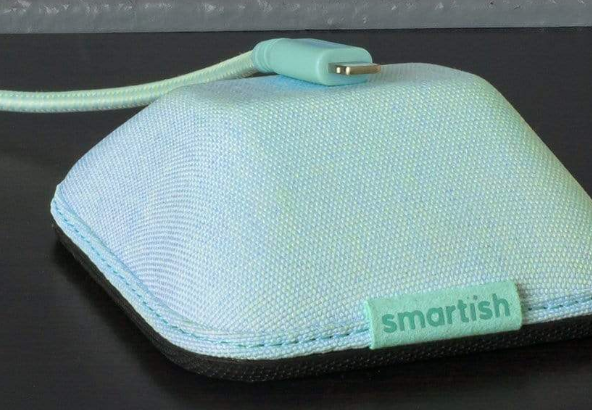
Smartish offers four colorful versions of the Cable Wrangler magnetic cord organizer, and it operates pretty much in the same way as MOS, but more colorfully.
The squat magnetic base is stable and sits neatly on a desk, kitchen counter, bedside table, or gaming station. It comes in one of four cloth-covered designer versions: No. 2 Pencil Grey, Lightly Toasted Beige, Teal Me More, and I’m Blushing. The grey is perfect for that back-to-school collegiate look, while the beige says, “Nancy Meyer-directed movie starring Diane Keaton or Meryl Streep, set on a California or New England beach,” or what GenZ and the Millennials are calling the “Coastal Grandmother” aesthetic. Of course, the pink-toned I’m Blushing was designed specifically for Paper Doll.
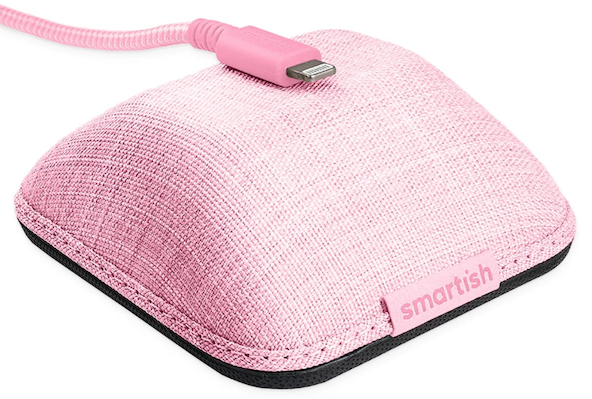
Cables stay put due to magnets, but if your particular cable isn’t feeling very “attractive” (that’s Smartish’s joke, if you don’t like it), you can use one of the three (included) magnetic “collars” (similar to the ones MOS had) to help improve the magnetic attraction and keep the cable stuck to the Wrangler. See it in action, below.
The Smartish Cable Wrangler is available at the Smartish site for $19.99, or with a 6-foot lightning cable and two-port wall charger for $39.99. For those who prefer to shop via Amazon Prime, all versions are $24.99. (Amazon also sells the Cable Wrangler with a cable and wall charger for $39.99.)
MUTESYNC: A MUTE BUTTON FOR YOUR VIDEO CALLS
“Hey, whoever’s dog is barking, can you mute yourself?”
“You’re on mute!”
“You’re still muted!”
Thanks to the pandemic, we’ve been in a Brady Bunch-boxed video conferencing mode since 2020, but doesn’t seem like any of us are getting much better at remembering to mute and un-mute. What we all need is the equivalent of that old Staples’ “Easy Button.”
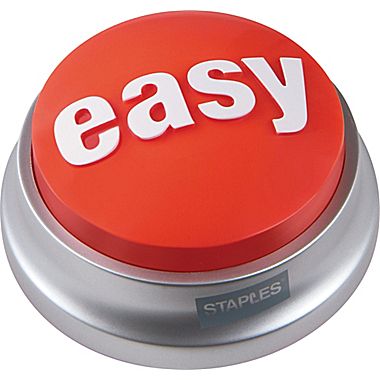
Well, the folks at MuteSync came up with exactly that, an Easy Button for muting/un-muting yourself and for prompting you to pay attention when you aren’t quick to do the right thing.
Instead of rushing your hand to the mouse or touch-screen to wake up the display, make your command icons visible, and click them to change your status, just tap the big, old button on your desk. BAM! MuteSync took their idea to Kickstarter, and it was a huge success! (I mean, of course it was. Seriously, how often do you say/hear “You’re on mute!” in a week?)
When you push the mute button (or even when you mute and unmute from your video meeting platform), the MuteSync mute button light changes! (And, duh, it mutes you.)
MuteSync buttons sync with Zoom, Google Meet, Microsoft Teams, Whereby and (with some hiccups) Discord; as of yet, there’s no love for Butter (my favorite under-appreciated video conferencing app).
Both Mac (from MacOS 10.10 (Yosemite) upward) and Windows (7.7 and above) are supported. Note that if you are using one of the conferencing platforms in the browser, MuteSync only supports Chrome and Brave, not Safari. Also, it does not work with phones or tablets, at least not yet. (But, honestly, finding the mute button on a phone or tablet is even harder, so they need to get on that!)
MuteSync requires the installation of a free, downloadable app, and the button connects to your computer (or hub) via an included USB-C cable.
Tapping the button toggles your mute on and off, and changes color to alert you (and anyone in your workspace) that you are muted (or, yikes!, not muted).
MuteSync users get the “Easy Button,” but also get an extra bonus, a free virtual mute button that lives in the menu bar at the top of the Mac or in the Windows system tray. The virtual button stays in sync with whatever’s going on with your conferencing platform, so if you’ve hit the mute button in Zoom, or tapped the MuteSync mute button, or even if the host has muted you (don’t worry, I’m sure she muted everyone but the speaker, so don’t take it personally!), the virtual button will work in lockstep.
The durable plastic MuteSync mute button is 2.4″ square and 0.4″ high, taking up minimal desk space. The bottom has a rubber pad to ensure that it grips the desk tightly and doesn’t go sliding around.

Because different people have different ideas of which colors mean on and off, you can customize the colors and brightness levels of the button’s eight LED light options.
You’ll still have to train your kids, your spouse who acts like a kid, and your exuberant pets so they understand which colors mean they should “shush”. And, if you’re like my peeps on my Friday night professional organizers call (you know who you are!), you may have to train your kitties to avoid stepping on the buttons when they think they’re the stars of the show.
Take a peek at the MuteSync video, and surf around the website, which has a variety of support videos and is written by folks with a fun, goofy sense of humor.
The MuteSync button is $49 at their website, as well as at Amazon.
While this is great for conferencing, I periodically have to record videos on Zoom, and I’ve got a horrible habit of narrating to myself (not-quite under my breath) when I have to switch from video to screen sharing, and when I have to pause in between steps. Yes, editing would allow me to deal with all of that, but I’m not always so technologically savvy (or inclined) with video editing; being able to quickly hit “mute” before before doing any fancy clicks would save me quite a bit of frustration.
What do you think? Could you use a portable, practically invisible, laptop stand? An attention-getting calendar? A fashion-forward cable organizer? An Easy Button to mute and un-mute your video calls?
Please share in the comments and let me know what you think, and what features or colors you wish had been included?

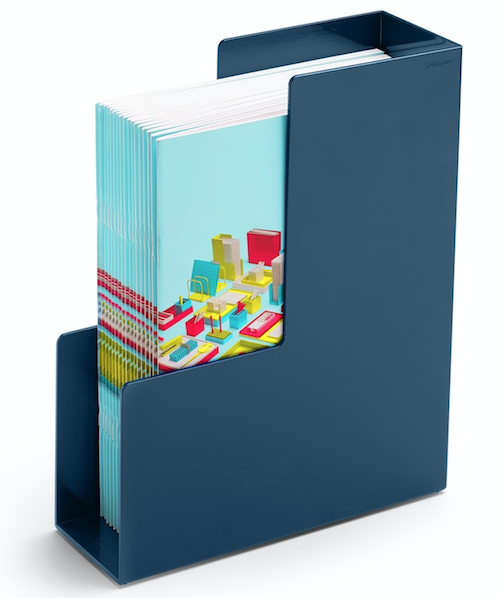
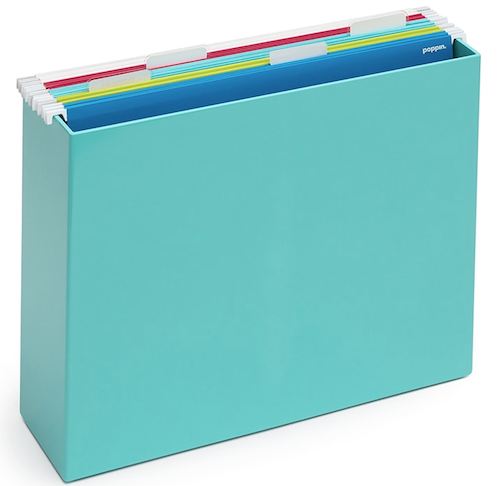






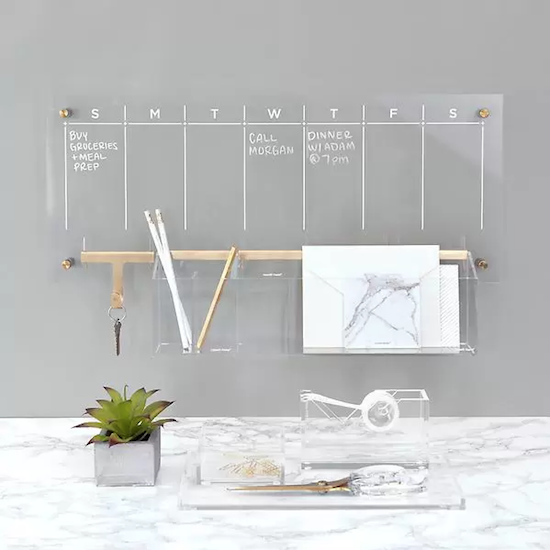



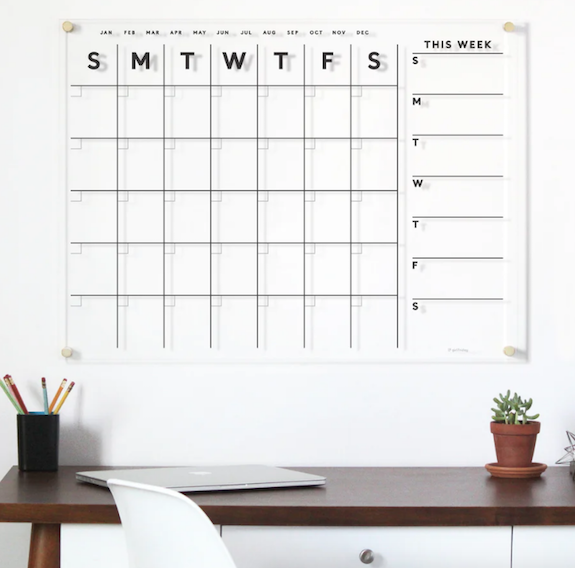
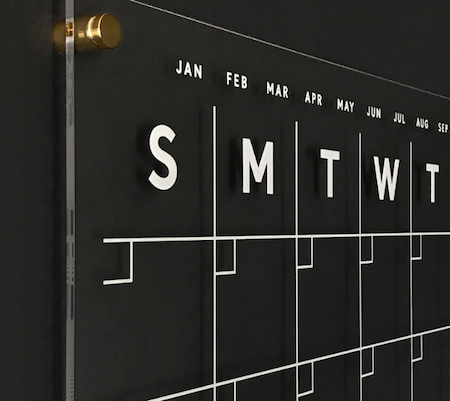

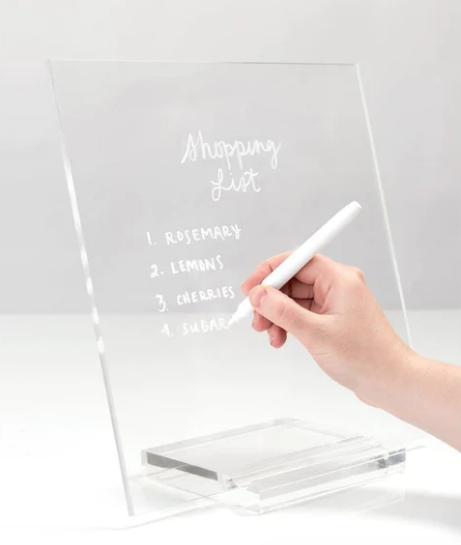




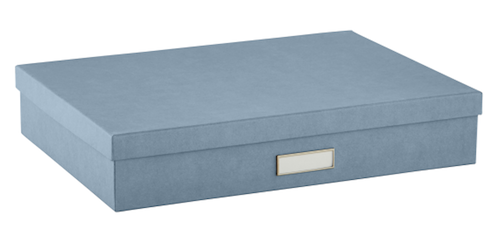
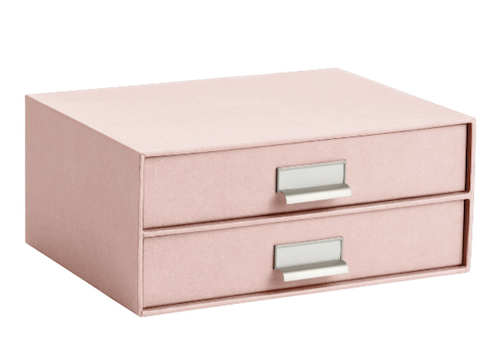 These kinds of boxes will take up about the same amount of desktop real estate as a tickler file or in-tray. However, the lid creates an out-of-sight, out-of-mind concern not present with in-box trays.
These kinds of boxes will take up about the same amount of desktop real estate as a tickler file or in-tray. However, the lid creates an out-of-sight, out-of-mind concern not present with in-box trays.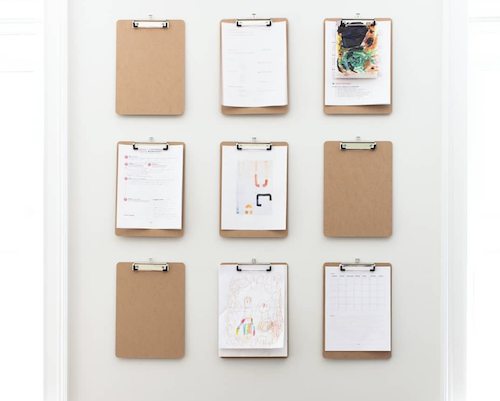






Follow Me